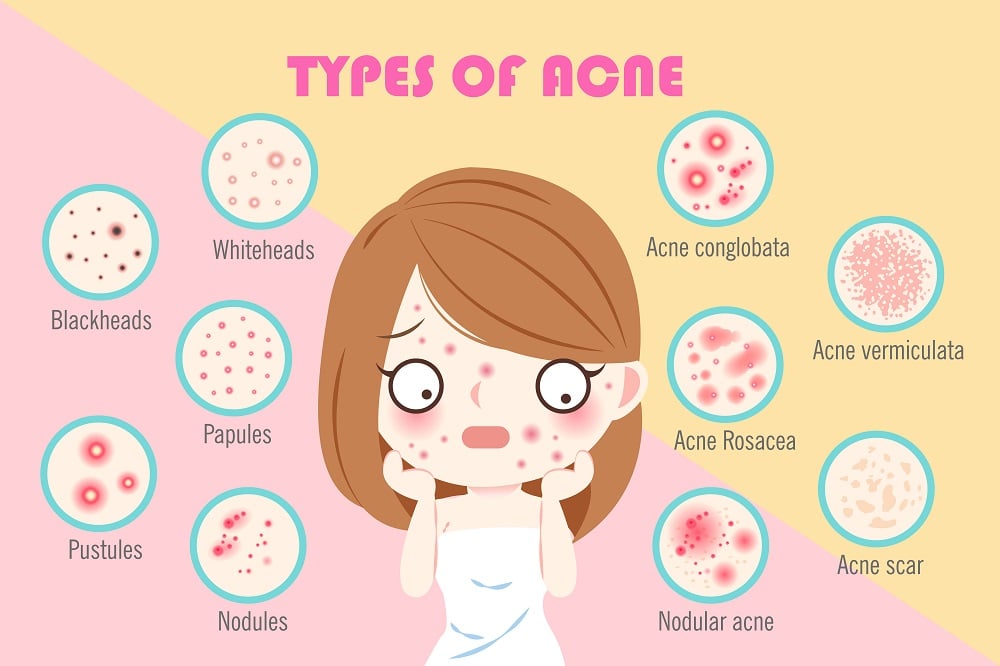
Lactoferrin and Its Effect on Acne
Please Note: This article relates to non cystic acne. For help with cystic acne, please consult with a dermatologist.
According to the American Academy of Dermatology, acne is the most common skin condition in the country, affecting over 50 million Americans every year. Treatments for acne include a wide range of ingredients and methods of delivery, but ongoing research suggests that lactoferrin may help to effectively treat acne. Learn more about how lactoferrin may help to relieve acne below.
Understanding Acne
Acne originates in the sebaceous glands of the pores. These glands secrete sebum, an oily substance that normally acts to moisturize the skin and protect it from harmful bacteria and pathogens. Oils also carry dead skin cells from the follicles to the surface of the skin. Unfortunately, excess sebum (often a result of hormonal changes) causes a blockage of oil and dead skin cells. This creates an environment where bacteria can thrive, which results in inflammation, characterized by swelling, redness, and pain.
Acne most commonly appears as whiteheads or blackheads, both of which are categorized as comedones. Whiteheads stay closed just under the surface of the skin, producing a small blemish filled with white pus. Blackheads remain open at the surface of the skin. The dark appearance results from oxygen interacting with melatonin in the pores. Along with whitehead and blackheads, acne can manifest in the form of various lesions, including:
- Cysts – Large, painful lumps that contain pus and exist deep under the skin
- Papules – Small, red, raised bumps that develop from hair follicles
- Pustules – Small, red bumps that often have pus at their tips (similar to whiteheads)
- Nodules – Solid, lumps located under the skin’s surface
What Causes Acne?
While the exact scientific cause(s) of acne still requires research, the four main factors that contribute to acne are:
- Excess sebum production
- Hair follicles that have been clogged by oil or dead skin cells
- Overactive hormones (particularly androgens)
- Bacteria
The primary acne-causing strain of bacteria is known as Propionibacterium acnes. P. acnes lives in the oily regions of the pores and can aggravate the immune responses that cause bumps that eventually develop into acne.
What is Lactoferrin?
Lactoferrin is a type of protein found naturally in cow milk and human milk as well as various other bodily fluids, including tears, saliva, and bile. However, it is most plentiful in colostrum, the milk-like fluid produced by female mammals in the first few days after giving birth to their young; colostrum production begins to taper off after about 72 hours, after which “true milk” is produced. Colostrum reportedly contains up to seven times as much lactoferrin as mature milk.
Lactoferrin’s main role involves supporting the immune system. Lactoferrin can also help:
- Support iron balance, ensuring that the body maintains enough of the mineral
- Regulate bone metabolism to support the removal of old bone material and replace it with new bone tissue
- Maintain a normal immune response
Iron and Lactoferrin
Iron is necessary to the synthesis of hemoglobin, the main protein that carries oxygen to red blood cells. However, as important as iron is to overall health, it also tends to be a magnet for pathogens. Negative bacteria often consume it to thrive and reproduce within the body.
Lactoferrin has the crucial role of regulating iron levels and removing excess iron to optimize health.
Lactoferrin and Acne

Lactoferrin works in several ways to potentially improve acne.
Iron Regulation
Through its iron-regulating role, lactoferrin essentially gets rid of the main food source for agents believe to lead to cause acne, including P. acnes. By starving P. acnes, lactoferrin can help to neutralize one of the main contributors to acne.
Antioxidant Properties
Along with its iron-regulating abilities, lactoferrin has also been shown to possess powerful antioxidant properties. Antioxidants work to combat free radicals, which have been created through the natural process of oxidation. Free radicals are known to cause damage to cells, tissue, and DNA itself, resulting in ongoing oxidative stress, which can promote causal factors which may lead to the formation of acne.
Skin Health Properties
Lactoferrin also offers skin health properties. Lactoferrin helps by stimulating connective tissue and epidermal cells to regenerate skin cells, all of which contributes to healthier skin with less causal factors which contribute to acne.
Gut Health
Most statements about diet and acne are myths (chocolate and greasy foods probably won’t trigger acne), but gut health is closely tied to acne formation. Poor gut and digestive health can lead to acne or exacerbate existing acne. You already know that lactoferrin can help to neutralize and eliminate negative bacteria, but lactoferrin can also help to feed the beneficial gut bacteria. Healthy gut flora can help to promote proper digestion and nutrient absorption.
Studies on Lactoferrin and Acne
Several studies suggest the growing potential for supplemental lactoferrin to support acne-free skin. In a double-blind, placebo-controlled study, participants aged 18 to 30 with varying forms of acne were given either fermented milk containing 200 milligrams of lactoferrin or fermented milk without any lactoferrin every day for a period of 12 weeks. During monthly visits, researchers assessed acne lesion counts and grades for each participant. Researchers also measured the condition of participants’ skin based on hydration, sebum, pH levels, and skin surface lipids (fats) prior to the study and at the 12-week mark.
At the end of the study, results showed significant improvements in the lactoferrin group. Lesion counts decreased by 38.6 percent, while total lesion counts decreased by 23.1 percent compared to the non-lactoferrin group. Acne grade went down by 20.3 percent compared to the placebo group. Sebum content went down by 31.1 percent in the lactoferrin group. The lactoferrin group also showed decreased amounts of triacylglycerols and free fatty acids, which correlated with significant decreases in sebum content, acne grade, and acne lesion count.
In another randomized, double-blind, placebo-controlled study, 168 participants between the ages of 13 and 40 were given either a capsule formulation of lactoferrin, vitamin E, and zinc or a placebo. Participants took these capsules twice a day for a period of three months. A total of 164 of the participants finished the study according to the protocol. The results showed that the lactoferrin group exhibited a significant median percent reduction of total lesions at just two weeks into the study. The maximum reduction occurred at the 10-week mark. The 10-week mark also saw a maximum reduction in comedones and lesions. Sebum scores also improved at week 12.
How to Take Lactoferrin for Acne
As mentioned, lactoferrin can be found in smaller quantities in cow milk. However, some studies suggest a link between dairy and acne. Dairy may irritate your acne and make it worse. Thankfully, lactoferrin is available in oral supplements, as well as existing naturally in bovine (cow) colostrum.
Other Ways to Improve Acne
In addition to taking supplemental lactoferrin, making some small lifestyle changes can go a long way to helping improve your acne.
- Drink more water – Staying hydrated is good for your overall health, but it can also help to flush out toxins and keep your body moisturized from the inside out. Drinking water can also help to increase blood flow to the skin.
- Stay active – Stress is one of the biggest contributors to acne and general ill health. One of the best ways to combat excess stress is to get some daily exercise. Staying active also increases blood circulation, which gives skin cells more oxygen and nutrients and helps to carry away cellular waste. Just make sure you wash away any sweat after your workout as sweat can irritate your skin and aggravate existing acne.
- Wash your face twice a day – Wash your face thoroughly but gently twice a day using a scent-free face cleanser. This helps to control oil secretions and wash away dirt, dead skin cells, and other pore-clogging debris. After cleansing, consider using a topical acne treatment, like salicylic acid, to actively combat breakouts.
- Wear sunscreen – Sun exposure can damage your skin, which may increase inflammation. This can lead to more acne and dark spots. More importantly, unprotected sun exposure increases your risk of skin cancer.
- Avoid touching your face – As tempting as it might be, don’t squeeze or pick at your acne. More often than not, this will lead to further irritation, more breakouts, and scarring.
Acne can be difficult to control, which can truly affect your confidence and self-esteem. By taking the right steps, you can potentially reduce your zits and clear up blemishes. Try to stay positive, but don’t beat yourself up if it gets too hard. While it’s okay to feel sad, annoyed, or angry about your acne, understand that your acne doesn’t define you or who you are. For best results, include a colostrum supplement in your daily diet. It positively contributes to good health in many other ways.
This article was brought to you by Sovereign Laboratories, a world leader in the development of liposomal delivery to maximize the bioavailability of our dietary supplements.Sources:
- https://www.aad.org/media/stats/conditions/skin-conditions-by-the-numbers
- https://www.niams.nih.gov/health-topics/acne#tab-overview
- https://www.healthline.com/symptom/acne
- https://www.mayoclinic.org/diseases-conditions/acne/symptoms-causes/syc-20368047
- https://www.medicalnewstoday.com/articles/257040.php
- https://www.sovereignlaboratories.com/blog/benefits-of-colostrum-ld/
- https://www.verywellhealth.com/the-benefits-of-lactoferrin-89471
- https://www.facingacne.com/lactoferrin-iron-affects-acne/
- https://www.ncbi.nlm.nih.gov/pubmed/20692602
- https://www.ncbi.nlm.nih.gov/pubmed/28369875
- https://www.healthline.com/health/dairy-and-acne
- https://www.webmd.com/skin-problems-and-treatments/acne/features/lifestyle#1



